Intro
Learn how to treat blisters on feet with effective remedies, preventing infection and promoting healing. Discover causes, symptoms, and home treatments for foot blisters.
Treating blisters on feet is a common concern for many individuals, particularly those who engage in regular physical activity, wear poorly fitting shoes, or have certain medical conditions. Blisters can be painful and uncomfortable, making it essential to understand the best ways to treat and prevent them. In this article, we will delve into the world of foot blisters, exploring their causes, symptoms, and treatment options.
Foot blisters are small, fluid-filled bubbles that form on the skin as a result of friction, pressure, or other forms of irritation. They can appear anywhere on the foot, but are most commonly found on the toes, heels, and balls of the feet. When a blister forms, it can be filled with clear fluid, blood, or pus, and may be surrounded by red, inflamed skin. While blisters can be painful and unsightly, they are usually not a cause for concern and can be treated with simple self-care measures.
The importance of treating blisters on feet cannot be overstated. If left untreated, blisters can become infected, leading to more serious complications such as cellulitis, abscesses, or even blood poisoning. Furthermore, untreated blisters can also lead to chronic pain, discomfort, and difficulty walking or engaging in physical activity. By understanding the causes of blisters and taking steps to prevent and treat them, individuals can reduce their risk of developing these complications and maintain healthy, happy feet.
Treating Blisters On Feet
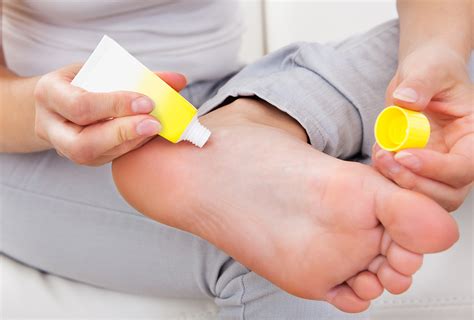
When it comes to treating blisters on feet, there are several options available. The first step is to leave the blister alone and avoid popping or draining it, as this can lead to infection and prolong the healing process. Instead, individuals can try applying a donut-shaped moleskin or blister shield to the affected area, which can help reduce friction and pressure. Additionally, applying a topical antibiotic ointment and covering the blister with a bandage can help prevent infection and promote healing.
Self-Care Measures
In addition to these treatment options, there are several self-care measures that individuals can take to help treat and prevent blisters on feet. These include wearing properly fitting shoes, changing socks regularly, and keeping the feet clean and dry. Individuals can also try applying a friction-reducing cream or powder to the feet, particularly in areas prone to blisters. Furthermore, taking regular breaks to rest and stretch the feet can help reduce pressure and friction, reducing the risk of blisters.Causes Of Blisters On Feet

Understanding the causes of blisters on feet is essential for preventing and treating them. Some common causes of blisters include friction, pressure, and irritation from poorly fitting shoes or socks. Other causes can include excessive walking or running, particularly on hard or uneven surfaces. Certain medical conditions, such as diabetes, eczema, or psoriasis, can also increase the risk of developing blisters on the feet. Additionally, individuals who wear orthotics or other foot devices may be more prone to blisters due to the increased pressure and friction on the feet.
Prevention Strategies
To prevent blisters on feet, individuals can take several steps. These include wearing properly fitting shoes and socks, applying a friction-reducing cream or powder to the feet, and taking regular breaks to rest and stretch the feet. Individuals can also try using orthotics or shoe inserts to reduce pressure and friction on the feet. Furthermore, keeping the feet clean and dry, and changing socks regularly can help prevent blisters by reducing moisture and friction.Types Of Blisters On Feet
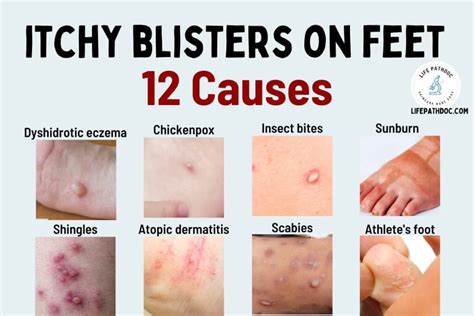
There are several types of blisters that can form on the feet, each with its own unique characteristics and treatment options. Clear blisters are the most common type, filled with clear fluid and usually appearing on the toes, heels, or balls of the feet. Blood blisters, on the other hand, are filled with blood and can appear anywhere on the foot. Pus-filled blisters are a sign of infection and require medical attention. Additionally, there are also friction blisters, pressure blisters, and heat blisters, each caused by different factors and requiring different treatment approaches.
Treatment Options
The treatment options for blisters on feet vary depending on the type and severity of the blister. For clear blisters, individuals can try applying a donut-shaped moleskin or blister shield to reduce friction and pressure. For blood blisters, individuals can try applying a cold compress to reduce pain and swelling. For pus-filled blisters, individuals should seek medical attention to have the blister drained and treated with antibiotics. Additionally, individuals can also try using over-the-counter pain relievers, such as ibuprofen or acetaminophen, to reduce pain and discomfort.Home Remedies For Blisters On Feet
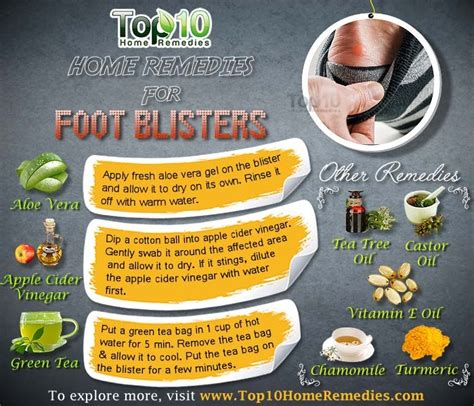
There are several home remedies that individuals can try to help treat and prevent blisters on feet. These include applying aloe vera gel or tea tree oil to the affected area to reduce inflammation and promote healing. Individuals can also try soaking the feet in warm water or applying a warm compress to reduce pain and discomfort. Additionally, individuals can try using baking soda or cornstarch to absorb moisture and reduce friction on the feet. Furthermore, eating a healthy diet rich in vitamins and minerals, particularly vitamin C and zinc, can help promote healing and reduce the risk of blisters.
Natural Treatments
In addition to these home remedies, there are also several natural treatments that individuals can try to help treat and prevent blisters on feet. These include applying coconut oil or shea butter to the affected area to moisturize and protect the skin. Individuals can also try using essential oils, such as lavender or peppermint, to reduce inflammation and promote healing. Additionally, individuals can try using herbal remedies, such as calendula or plantain, to reduce pain and discomfort. Furthermore, practicing good foot hygiene, such as washing the feet regularly and drying them thoroughly, can help prevent blisters by reducing moisture and friction.When To Seek Medical Attention
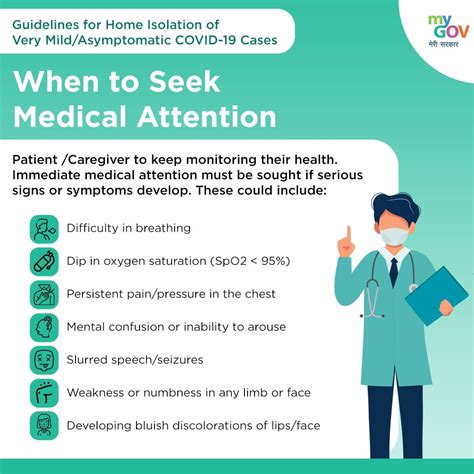
While most blisters on feet can be treated with self-care measures and home remedies, there are certain situations in which individuals should seek medical attention. These include if the blister becomes infected, as indicated by increased redness, swelling, or pus. Individuals should also seek medical attention if the blister is large or painful, or if it does not heal on its own after a few days. Additionally, individuals with certain medical conditions, such as diabetes, should seek medical attention if they develop a blister on their foot, as they may be at increased risk of complications.
Medical Treatment Options
If individuals need to seek medical attention for a blister on their foot, there are several treatment options available. These include antibiotics to treat infection, as well as pain relievers to reduce discomfort. In some cases, individuals may need to have the blister drained or debrided to promote healing. Additionally, individuals may need to wear a cast or boot to reduce pressure and friction on the foot, or use crutches to avoid putting weight on the affected area. Furthermore, individuals may need to undergo physical therapy to promote healing and prevent future blisters.Preventing Blisters On Feet
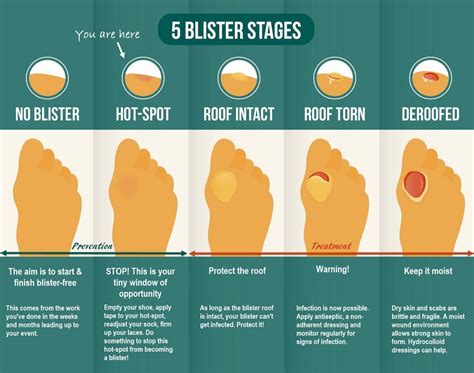
Preventing blisters on feet is essential for maintaining healthy, happy feet. Individuals can take several steps to prevent blisters, including wearing properly fitting shoes and socks, applying a friction-reducing cream or powder to the feet, and taking regular breaks to rest and stretch the feet. Individuals can also try using orthotics or shoe inserts to reduce pressure and friction on the feet. Furthermore, keeping the feet clean and dry, and changing socks regularly can help prevent blisters by reducing moisture and friction.
Foot Care Tips
In addition to these prevention strategies, there are also several foot care tips that individuals can follow to help prevent blisters on feet. These include washing the feet regularly and drying them thoroughly, particularly between the toes. Individuals can also try trimming their toenails straight across to avoid ingrown toenails, and avoiding sharing shoes or socks to reduce the risk of fungal infections. Additionally, individuals can try using a pumice stone or foot file to remove dead skin cells and smooth out rough patches on the feet. Furthermore, individuals can try getting regular foot massages to promote blood flow and reduce tension in the feet.What causes blisters on feet?
+Blisters on feet are caused by friction, pressure, and irritation from poorly fitting shoes or socks, as well as excessive walking or running, and certain medical conditions such as diabetes, eczema, or psoriasis.
How can I treat blisters on feet?
+To treat blisters on feet, individuals can try applying a donut-shaped moleskin or blister shield to reduce friction and pressure, as well as applying a topical antibiotic ointment and covering the blister with a bandage to prevent infection and promote healing.
How can I prevent blisters on feet?
+To prevent blisters on feet, individuals can try wearing properly fitting shoes and socks, applying a friction-reducing cream or powder to the feet, and taking regular breaks to rest and stretch the feet. Individuals can also try using orthotics or shoe inserts to reduce pressure and friction on the feet.
In conclusion, treating blisters on feet requires a comprehensive approach that includes understanding the causes and symptoms of blisters, as well as taking steps to prevent and treat them. By following the tips and strategies outlined in this article, individuals can reduce their risk of developing blisters and promote healthy, happy feet. We encourage readers to share their own experiences and tips for treating and preventing blisters on feet in the comments below, and to share this article with others who may be struggling with foot blisters.
